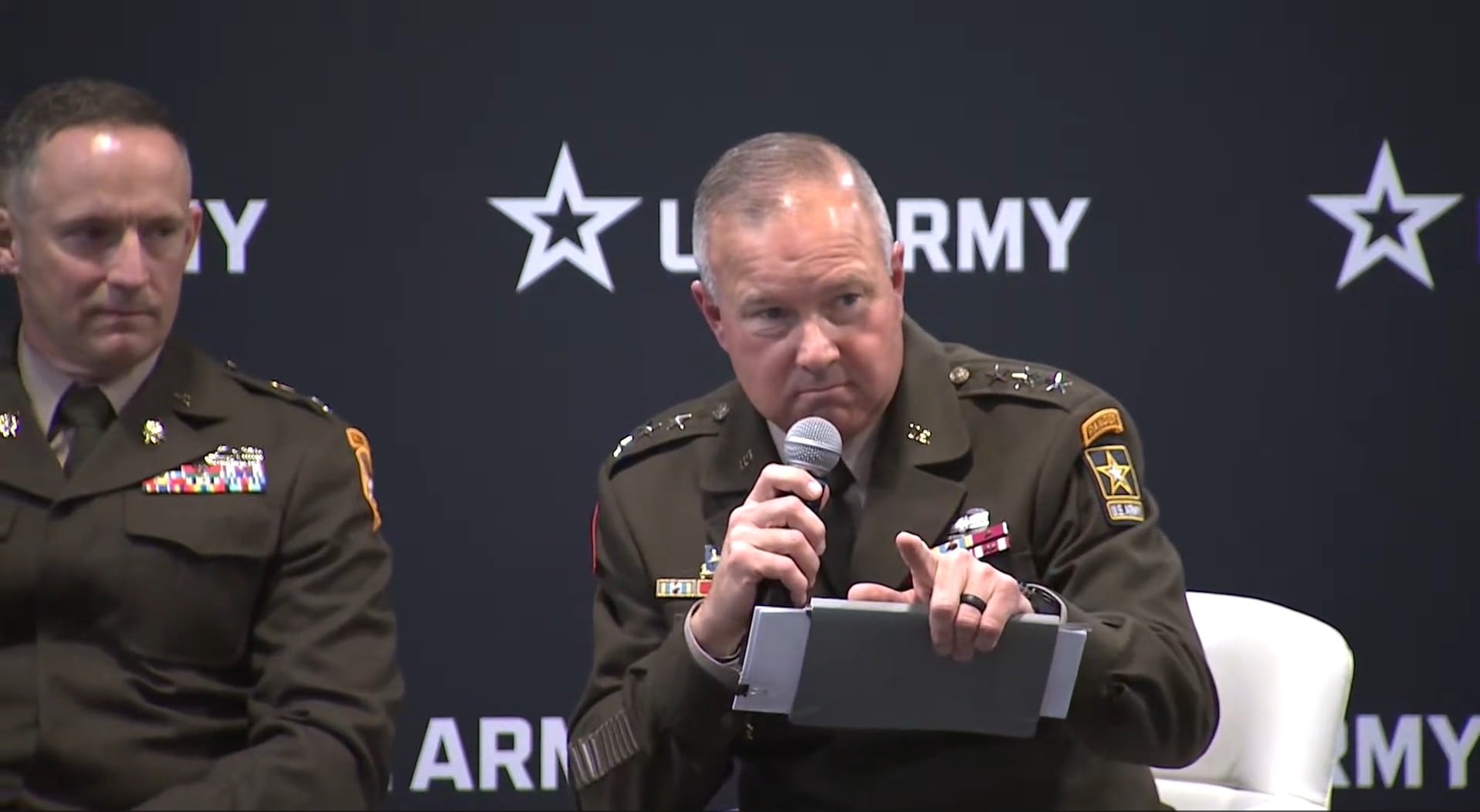Never mind the mere beta status of the Army’s new app for operating howitzers, soldiers of the 4th Infantry Division at Fort Carson, Colorado, were itching to find out whether four decades of the existing, error-prone system were finally coming to an end.
So they hooked up their M777 to the novel Artillery Execution Suite during an exercise last month and pulled the lanyard.
Users of the legacy software, the Advanced Field Artillery Tactical Data System, had become accustomed to working around problems.
Troubleshooting was just the normal part of operating the system, Maj. Gen. Patrick Ellis, the 4th ID commander, told Defense News in a recent interview.
The new software, AXS, is a module of the overarching Next-Generation Command-and-Control, or NGC2, envisioned to power all Army battlefield operations.
Exercise Ivy Sting, a series meant to help develop a prototype for NGC2, was deemed the perfect opportunity for a trial run for the howitzer crew, and compare it to the old system.
The tests showed that AXS can drastically shorten what artillerists call the “kill chain,” according to Ellis.
The gun was ready to fire even before the unit finished digging in the two titanium spades on the back of the howitzer used to stabilize it in the ground, he said.
“If you talk to these artillery operators, they will tell you that this was a life changing event for them.”
While the first round of Ivy Sting was focused on the fires C2 element, the division is committed to testing the entire NGC2 prototype. That consists of a four-layer stack: the app layer, data layer, infrastructure layer, and transport layer.
When he took over the service two years ago, Army Chief of Staff Gen. Randy George recognized getting command-and-control right was imperative to future battlefield success and decided to embark on a program to fix the service’s C2 capabilities to avoid operational disruption while creating the necessary clean-sheet system from scratch.
At the same time, the Army began a proof-of-concept of a next-gen C2 system that would be a complete departure from using anything the service already had in its inventory, and the plan was to develop it and scale it for division use within just a few years.
“I put out two years ago that we have to fix the network as our number one priority, that we have to be data centric,” George told Defense News in a recent interview. “It really impacts everything that we do across every warfighting function and to be leaner, lower signature and more lethal, we would need to have something like Next-Gen C2,” he said. “It remains a priority for us.”
Getting NGC2 right means faster decisions in the field. “What we do know is that whoever can make decisions and act the fastest will probably win the next conflict and the network is central to all of that,” Army Vice Chief of Staff Gen. James Mingus told Defense News.
“We are convinced that if we get that part right, there will be a day when our soldiers, instead of carrying multiple radios, batteries, and tethered equipment, will only need an end-user device at the edge,” he said. “That will be all they need for the next fight.”
From the ground up
Starting from scratch, the Army put together a proof-of-concept, with companies like Google, Palantir and Anduril, demonstrating how it would share data seamlessly between command posts while reducing the footprint and signature at Project Convergence, a demo event, at the National Training Center at Fort Irwin, California, in March 2024.
That technological foundation behind the effort showcased a static prototype of the network’s data-sharing architecture, Brig. Gen. Michael Kaloostian, who leads the Army’s Next-Generation Command-and-Control cross-functional team, told Defense News in an interview.
By the next round of Project Convergence earlier in 2025, the Army had a proof-of-principle of the entire four-layer tech stack, which was tested in a live environment with an armored battalion and even contested by an opposing force.
When the digital tools were turned off and the battalion reverted to legacy comms, the difference was stark.
“The OPFOR was using traditional comms,” Kaloostian said, “and our forces were using next-gen C2 and they had a decisive advantage,” he said. “When we took all of that stuff away … it was really kind of parity with the opposing force.”
The Army is now scaling the system to the entire 4th ID division, and by next summer, that division will take it to the next Project Convergence. The division will continue in the lead through Project Convergence Capstone 7 in 2027.
To get there, the service awarded contracts in July for an industry team led by Anduril to build a prototype capability leveraging technology already part of the pilot efforts.
The team will work alongside soldiers in the field throughout the effort to refine the capability across aviation, logistics and sustainment formations.
The Anduril team, which was awarded a $99.6 million contract to deliver a prototype in less than a year, has other tech industry heavyweights like Palantir on board.
The prototype architecture will consist of “integrated and scalable” C2 capabilities using hardware, software and applications through a common data layer, the Army stated in a July 18 announcement.
The service is also providing the 25th ID in Hawaii with another prototype capability.
The Army awarded Lockheed Martin Rotary and Mission Systems a contract to lead a team with innovators like Raft and Hypergiant to develop the second NGC2 prototype architecture going to the 25th ID.
Sting and strike
The 4th ID is now embarking on a series of experimentation events with its NGC2 prototype stack called Ivy Sting. These events will occur every month as “a building block” until a culminating event the division is calling Ivy Mass, according to Ellis.
“It’s kind of almost a continual prototyping effort,” Ellis said. “We are not in experimentation anymore. We are the Next-Gen C2 prototype division.”
The Ivy Mass exercise next May will be a large-scale mission rehearsal ahead of Project Convergence at the National Training Center, Ellis noted.
The first round of Ivy Sting last month devoted to fires – connecting sensors to shooters – was the logical place to begin because it forced the Army to integrate every other data source along the way, Ellis said.
“In order to effectively shoot artillery … you have to be able to ingest target data,” he said. “A lot of that comes from the Army Intel Data Platform. You also need to know where all your logistics are, where the artillery rounds are.”
That effort has also given soldiers direct experience shaping the tools they’ll use.
“We didn’t want the perfect product,” Ellis said. “We wanted the product, and now we’re helping make it better.”
Future Ivy Sting events will focus on airspace management, artificial intelligence for targeting, and the integration of operational simulations, which are digital “what-if” tools that let commanders test plans against enemy movement.
“It’s not a video game,” Ellis said, “but … a simulation tool for a commander to use to say, ‘Here’s where all my blue units are. Here’s where I understand the red units to be. What happens if I go left or right?’”
Between each Ivy Sting iteration, soldiers and engineers are also conducting rapid “sprints,” tackling specific digital problems and meeting in what the Army calls solution summits, which are open working sessions where soldiers describe what isn’t working and industry developers push updates back within days or weeks.
“They actually interact with industry partners, and they interact with teammates from across the acquisition community, and they have a back-and-forth,” Ellis said. “What it’s doing is it’s starting to drive two Stings into the future … it’s kind of a roadmap that gets us ready.”
The 25th ID will conduct similar sprints, beginning with one later this fall, called Lightning Strike.
Night and day
The Army is also reworking the typical acquisition system for the effort to support the pace, according to Joe Welch, deputy chief of staff of Army Futures Command.
For one, the Army used a new mechanism it’s calling “fast pass” to get initial requirements for the NGC2 through its oversight paces in order to move quickly to get capability into formations, Lt. Gen. Karl Gingrich, the Army G-8, told Defense News.
Moving quickly to get systems into soldiers’ hands has resulted in rapid improvement. For one, Ivy Sting has shown the vast difference in performance between using a digital fires thread versus legacy capabilities.
“It’s just night and day,” Welch said.
NGC2’s new partnership model pairing government integrators with commercial teams is reshaping how the Army develops software, he stressed.
“What we’ve set out with our acquisition partners on NGC2 is really this industry team lead, partnership model,” Welch said. “We’re really using this period … to look at what is the most effective working relationship, because this is something we really haven’t done before.”
The Army has also had to reorganize how it budgets for C2 capabilities, Welch noted.
“We looked across all of the disparate budget line items in the Army that had something to do with delivery of a C2 capability,” he said. “In the ’26 budget submit … we have done a lot of that framework that would better support the NGC2 concept.”
By consolidating those funds, the Army hopes to move money faster and sustain momentum across its modernization programs.
The program’s rapid evolution has led to some concern that the system is vulnerable and presents security risks.
“I think as part of any network development or integration work, you’re going to have deliberate processes for identifying seams,” Brig. Gen. Shane Taylor, program executive officer for Army Command, Control, Communications and Network, said in a recent interview. “It could be cyber security challenges. Where can we build cyber resiliency into the system?”
The Army is doing that work as part of Ivy Sting, he said. “There are exercises built into that, or learning demands built into that, where we’re going to look at things like spectrum and look at efforts like red teaming, where we can identify cyber challenges.”
External work in a lab is also reducing risk, he noted.
Already after the first iteration of Ivy Sting, the Army has “rapidly burned down those risks to an acceptable level,” Taylor said.
As Army leaders continue to press on to fund and organize the Army’s number one priority, what drives the soldiers in 4th ID is more immediate, the chance to be part of a generational change.
The 4th ID is known as the first digital division, but it was minted as such in 2003, Ellis said. “We’ve been using that same technology since 2003, so the fact that soldiers now get the opportunity to be part of something new, it’s really exciting.”
Leaders across the Army “feel the pressure very personally to get this right for the rest of the Army,” Ellis said. “Our goal is to deliver a quality product … across the Army.”
Jen Judson is an award-winning journalist covering land warfare for Defense News. She has also worked for Politico and Inside Defense. She holds a Master of Science degree in journalism from Boston University and a Bachelor of Arts degree from Kenyon College.





